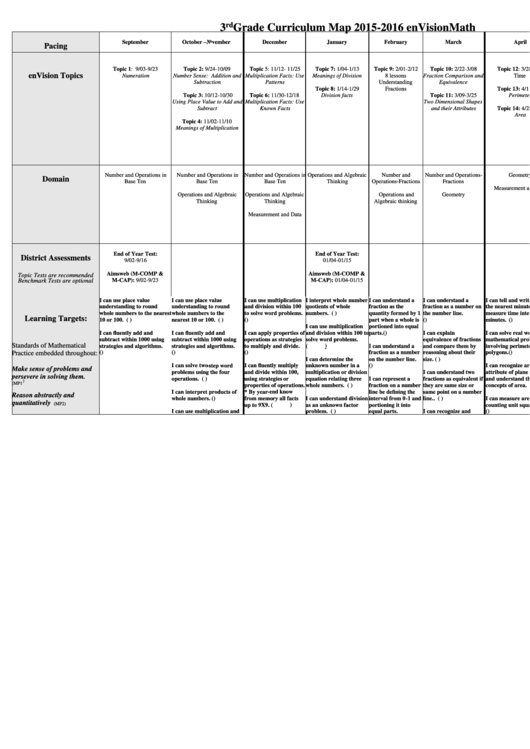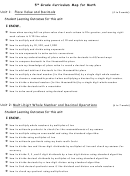Third Grade Curriculum Map Maths
ADVERTISEMENT
rd
3
Grade Curriculum Map 2015-2016 enVisionMath
September
October –November
December
January
February
March
April
May
June
Pacing
Topic 1: 9/03-9/23
Topic 2: 9/24-10/09
Topic 5: 11/12- 11/25
Topic 7: 1/04-1/13
Topic 9: 2/01-2/12
Topic 10: 2/22-3/08
Topic 12: 3/28-4/08
Topic 15: 5/18-5/27
Step up to Fourth
enVision Topics
Numeration
Number Sense: Addition and
Multiplication Facts: Use
Meanings of Division
8 lessons
Fraction Comparison and
Time
Liquid Volume
Grade: End of June
Subtraction
Patterns
Understanding
Equivalence
6/13-6/17
Topic 8: 1/14-1/29
Fractions
Topic 13: 4/11-4/27
Topic 16: 5/31-6/10
Topic 3: 10/12-10/30
Topic 6: 11/30-12/18
Division facts
Topic 11: 3/09-3/25
Perimeter
Data
Using Place Value to Add and
Multiplication Facts: Use
Two Dimensional Shapes
and Mass
Subtract
Known Facts
and their Attributes
Topic 14: 4/28-5/17
Area
Topic 4: 11/02-11/10
Meanings of Multiplication
Number and Operations in
Number and Operations in
Number and Operations in
Operations and Algebraic
Number and
Number and Operations-
Geometry
Measurement and Data
Number and
Domain
Base Ten
Base Ten
Base Ten
Thinking
Operations-Fractions
Fractions
Operations in Base
Measurement and Data
Ten
Operations and Algebraic
Operations and Algebraic
Operations and
Geometry
Thinking
Thinking
Algebraic thinking
Operations and
Algebraic Thinking
Measurement and Data
Number and
Operations-Fractions
End of Year Test:
End of Year Test:
End of Year Test:
District Assessments
9/02-9/16
01/04-01/15
05/04-06/08
Aimsweb (M-COMP &
Aimsweb (M-COMP &
Aimsweb (M-COMP
Topic Tests are recommended
M-CAP): 9/02-9/23
M-CAP): 01/04-01/15
& M-CAP): 05/09-
Benchmark Tests are optional
05/20
I can use place value
I can use place value
I can use multiplication
I interpret whole number
I can understand a
I can understand a
I can tell and write time to
I can measure and
I can multiply a
understanding to round
understanding to round
and division within 100
quotients of whole
fraction as the
fraction as a number on
the nearest minute and
estimate liquid volumes
whole number of up
whole numbers to the nearest
whole numbers to the
to solve word problems.
numbers. (3.OA.2)
quantity formed by 1
the number line.
measure time intervals in
and masses of objects
to four digits by a
Learning Targets:
10 or 100. (3.NBT.1)
nearest 10 or 100. (3.NBT.1)
(3.OA.3)
part when a whole is
(3.NF.2)
minutes. (3.MD.1)
using standard units of
one-digit whole
I can use multiplication
portioned into equal
grams, kilograms, and
number and multiply
I can fluently add and
I can fluently add and
I can apply properties of
and division within 100 to
parts.(3.NF.1)
I can explain
I can solve real world and
liters. (3.MD.2)
two two-digit
subtract within 1000 using
subtract within 1000 using
operations as strategies
solve word problems.
equivalence of fractions
mathematical problems
numbers and
Standards of Mathematical
strategies and algorithms.
strategies and algorithms.
to multiply and divide.
(3.OA.3)
I can understand a
and compare them by
involving perimeter of
I can draw scaled
illustrate and explain
Practice embedded throughout:
(3.NBT.2)
(3.NBT.2)
(3.OA.5)
fraction as a number
reasoning about their
polygons.(3.MD.8)
picture and bar graphs
the calculation by
I can determine the
on the number line.
size. (3.NF.3)
to represent data and
using equations,
I can solve two-step word
I can fluently multiply
unknown number in a
(3.NF.2)
I can recognize area as an
solve problems with
rectangular arrays,
Make sense of problems and
problems using the four
and divide within 100,
multiplication or division
I can understand two
attribute of plane figures
them. (3.MD.3)
and/or area models.
persevere in solving them.
operations. (3.OA.8)
using strategies or
equation relating three
I can represent a
fractions as equivalent if
and understand the
(4.NBT.5)
(MP1)
properties of operations.
whole numbers. (3.OA.4)
fraction on a number
they are same size or
concepts of area. (3.MD.5)
I can measure to
I can interpret products of
* By year-end know
line be defining the
same point on a number
generate data and show
I can find quotients
Reason abstractly and
whole numbers. (3.OA.1)
from memory all facts
I can understand division
interval from 0-1 and
line.. (3.NF.3a)
I can measure areas by
and remainders with
the data on a line plot.
quantitatively
(MP2)
up to 9X9. (3.OA.7)
as an unknown factor
portioning it into
counting unit squares.
(3.MD.4)
up to four digit
I can use multiplication and
problem. (3.OA.6)
equal parts.
I can recognize and
(3.MD.6)
dividends with a one
September 2015
ADVERTISEMENT
0 votes
Related Articles
Related forms
Related Categories
Parent category: Education
 1
1 2
2








